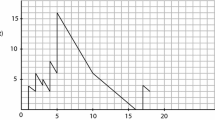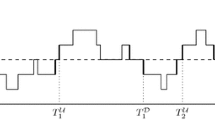Abstract
In the spirit of Little’s law \(L=\lambda W\) and its extension \(H=\lambda G\) we use sample-path analysis to give a general conservation law. For queueing models the law relates the asymptotic average workload in the system to the conditional asymptotic average sojourn time and service times distribution function. This law generalizes previously obtained conservation laws for both single- and multi-server systems, and anticipating and non-anticipating scheduling disciplines. Applications to single- and multi-class queueing and other systems that illustrate the versatility of this law are given. In particular, we show that, for anticipative and non-anticipative scheduling rules, the unconditional delay in a queue is related to the covariance of service times and queueing delays.
Similar content being viewed by others
References
Ayesta, U.: A unifying conservation law for single-server queues. J. Appl. Probab. 44, 1078–1087 (2007)
Baccelli, F., Brémaud, P.: Elements of Queueing Theory: Palm Martingale Calculus and Stochastic Recurrences, Applications of Mathematics, vol. 26. Springer, New York (1994)
Bartsch, B., Bolch, G.: Conservation law for G/G/m queueing systems. Acta Inform. 810, 105–109 (1978)
Dacre, M., Glazebrook, K., Niño-Mora, J.: The achievable region approach to the optimal control of stochastic systems. J. R. Stat. Soc. B 61, 747–791 (1999)
El-Taha, M.: Asymptotic time averages and frequency distributions. Int. J. Stochastic Anal. 2016, Article ID 2741214. doi:10.1155/2016/2741214 (2016)
El-Taha, M.: Invariance of workload in queueing systems. Queueing Syst. 83(1–2), 181–192 (2016)
El-Taha, M., Stidham Jr., S.: Sample-Path Analysis of Queueing Systems. Kluwer Academic Publishing, Boston (1999)
Federgruen, A., Groenevelt, H.: M/G/c queueing systems with multiple customer classes: characterization and control of achievable performance under nonpreemptive priority rules. Manag. Sci. 34, 1121–1138 (1988)
Gelenbe, E., Mitrani, I.: Analysis and Synthesis of Computer Systems. Academic Press, London (1980)
Green, T., Stidham Jr., S.: Sample-path conservation laws, with applications to scheduling queues and fluid systems. Queueing Syst. 36, 175–199 (2000)
Gross, D., Shortle, J.F., Thompson, J.M., Harris, C.: Fundamentals of Queueing Theory, 4th edn. Wiley, Hoboken (2008)
Heyman, D., Sobel, M.: Stochastic Models in Operations Research, vol. I. McGraw-Hill, New York (1982)
Heyman, D.P., Stidham Jr., S.: The relation between customer and time averages in queues. Oper. Res. 28, 983–994 (1980)
Kleinrock, L.: Queueing Systems, vol. II. Wiley Intersciences, New York (1976)
Kleinrock, L., Muntz, R.R., Hsu, J.: Tight bounds on average response time for time-shared computer systems. Proc. IFIP Congr. 1, 124–133 (1971)
Niño Mora, J.: Conservation Laws and Related Applications. Wiley Encyclopedia of Operations Research and Management Science, London (2011)
O’Donovan, T.M.: Distribution of attained service and residual service in general queueing systems. Oper. Res. 22, 570–574 (1974)
Shanthikumar, J.G., Yao, D.D.: Multiclass queueing systems: polynomial structure and optimal scheduling control. Oper. Res. 40(Suppl 2), S293–S299 (1992)
Tsoucas, P.: The region of achievable performance in a model of klimov. Technical report, Thomas J. Watson IBM Research Center. Research Division., T.J. Watson Research Center, Yorktown Hts., New York, NY 10598 (1991)
Whitt, W.: Embedded renewal processes in the \({GI}/{G}/s\) queue. J. Appl. Probab. 9, 650–658 (1972)
Wolff, R.: Stochastic Modeling and the Theory of Queues. Prentice Hall, Englewood Cliffs, NJ (1989)
Acknowledgements
The author wishes to thank the reviewers for their helpful comments.
Author information
Authors and Affiliations
Corresponding author
Appendix
Appendix
Our first result is a bound on the busy period for a single-server queue. Let \(\{A_k= T_k-T_{k-1}, k\ge 1\}\) be the sequence of inter-arrival times, and define \(A'_k=\min \{A_k,M\}\), where M is chosen such that \(\lambda ' ES <1\); i.e., \(\lambda<\lambda '<\mu \), (\(\mu =1/ES\)). Here \(\lambda '\) is the arrival rate of the new modified system. Also, let EB be the long-run average length of a busy period.
Lemma 4.1
Let \(\rho <1\), then for a G / G / 1 model where relevant limits are well-defined, we have
Proof
We follow the notation used in El-Taha and Stidham [7, pp. 25–26]. Let A(0, t), Y(0, t) (\(A'(0,t)\), and \( Y'(0,t)\)) be the original (modified) system arrivals that find the system in state 0 and total time in state 0 during [0, t), respectively. Note that \(A'(0,t) \le A(0,t)\) and \(Y'(0,t)\le Y(0,t)\). This follows by noting the effect of reducing inter-arrival times on, possibly, joining neighboring busy periods. Using Theorem 1.12 and Example 1.7 in El-Taha and Stidham [7, p. 26], the long-run average idle period for the modified system \(I'=\lambda '(0)^{-1} \le M\); moreover,
Therefore,
which completes the proof. \(\square \)
Ayesta [1] gives an upper bound for the busy period of a single-server queue using a different approach. Our bound is given using a sample-path approach consistent with the article analysis. No stochastic assumptions are used. In the same spirit, we prove the second result that is needed in the proof of Corollary 2.3.
Lemma 4.2
Suppose that \(E[S^2] = \int _{0}^{\infty }x^2 \mathrm{d}F(x) <\infty \), then
Proof
Note that
Now, taking limits of both sides as \(x \rightarrow \infty \) leads to
Therefore,
Now,
The following known result does not seem to be well-reported in the literature. \(\square \)
Lemma 4.3
Let f(x) be a monotone continuous function, then
Proof
We start by computing the integral \(\int _{f(a)}^{f(b)} f^{-1}(y)\mathrm{d}y\). Let \(x=f^{-1}(y)\), so that \(y=f(x)\) and \(\mathrm{d}y=\mathrm{d}f(x)\). Thus, using integration by parts,
\(\square \)
Suppose that \(a=f(a)=0\). Then this lemma says the integral of f plus the integral of its inverse give the area of the rectangle with sides b and f(b).
Rights and permissions
About this article
Cite this article
El-Taha, M. A general workload conservation law with applications to queueing systems. Queueing Syst 85, 361–381 (2017). https://doi.org/10.1007/s11134-017-9515-4
Received:
Revised:
Published:
Issue Date:
DOI: https://doi.org/10.1007/s11134-017-9515-4




